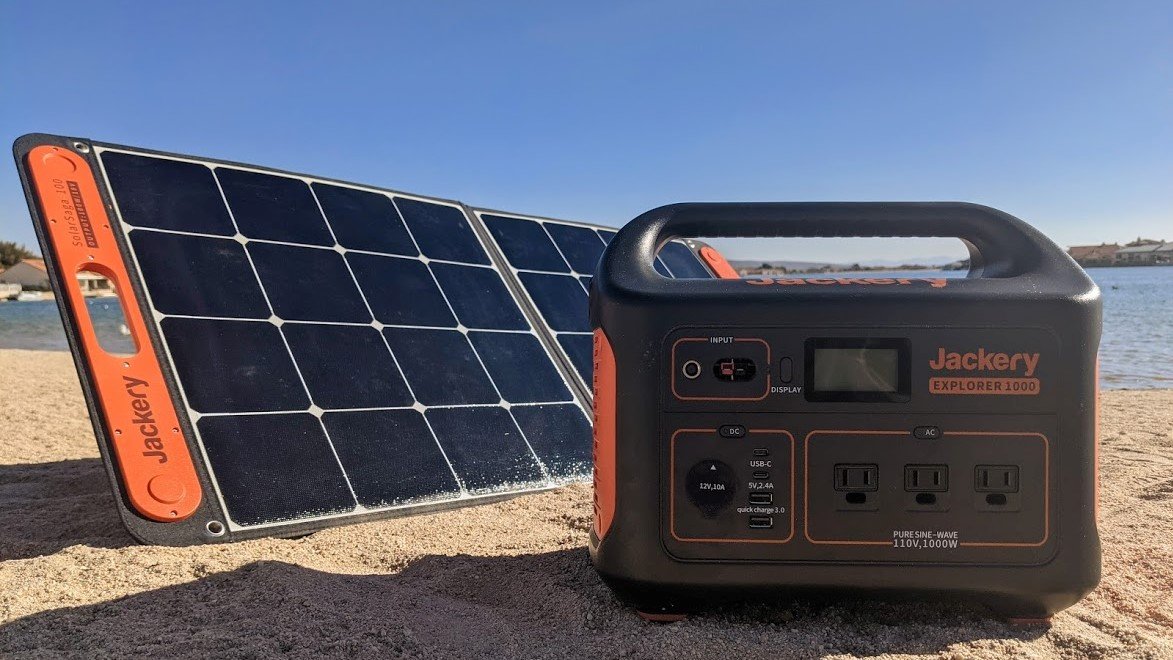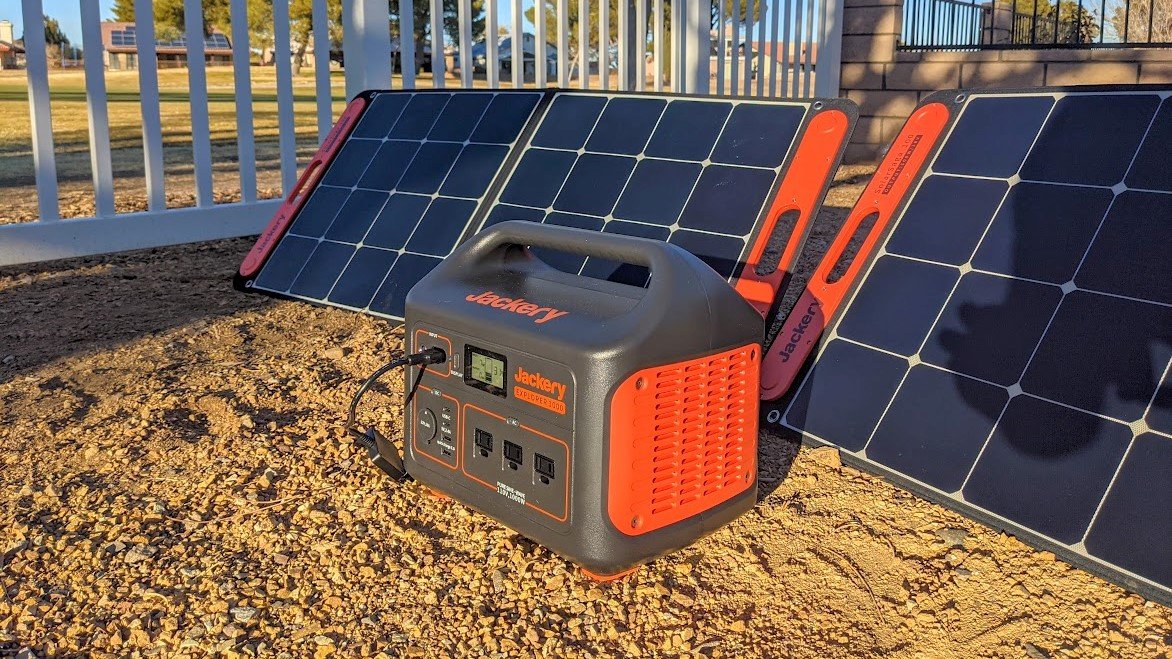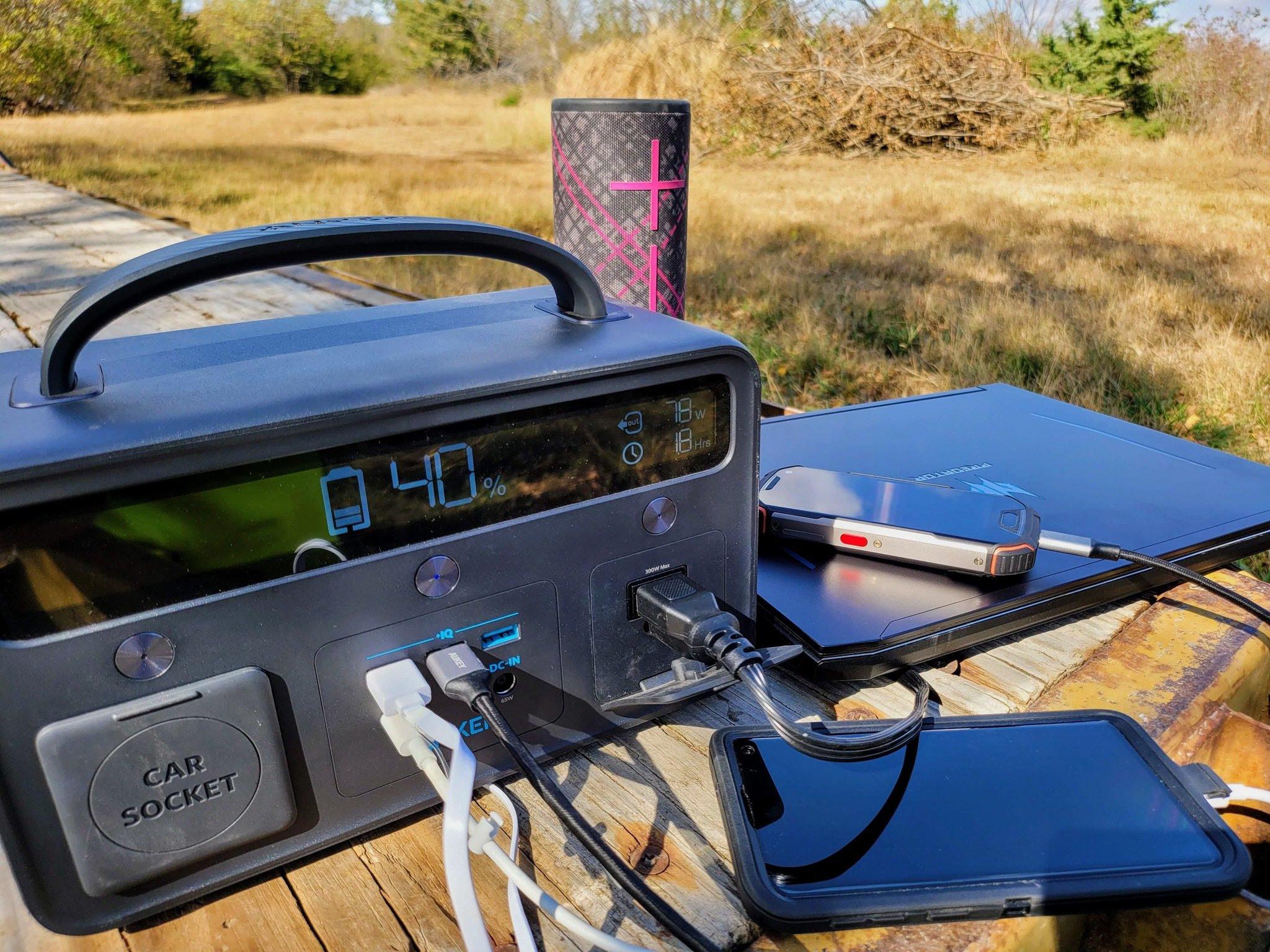The Jackery 1000, coupled with the solar panels, is a dream come true for anyone on the road.
Camping in the modern age is a different prospect than it used to be. Even when we are out in the wilderness, we like to stay connected, so we need a way to charge our devices. With more people working from home, there are many chances to work in unconventional places. Our very own Ara Wagoner loves to work from anywhere with a great Chromebook, and I've been known to go and sit by the lake to write reviews. Keeping your phone and Chromebook charged is easy with a Jackery Explorer — especially if you take advantage of the sun.
Jackery Explorer 1000 with solar panels
Bottom line: Whether you are looking for a power supply while out camping or just in the backyard, the Jackery Explorer 1000 is the perfect setup for almost limitless power.
The Good
- Huge battery life
- Solar panels work independently
- Eight outputs
The Bad
- It is not cheap
- The solar cables could be longer
Jackery Explorer 1000: Price and availability
The Explorer 1000 as a base unit is $1,000, while the two solar panels cost $300 each. Happily, if you get the bundle that Jackery sent me for review, you'll save $100 off that original price. There always seems to be plenty of stock at Amazon and the Jackery website, so getting hold of one before the summer shouldn't be an issue at all.
The big Explorer 1000 has remained at a steady price throughout its life, but it does occasionally get coupons at Amazon that lower the cost by $100, so it's always worth keeping an out for those times.
Jackery Explorer 1000: What's good
The very first thing I noticed when I broke out the Explorer 1000 (E1000) for the first time was its sheer number of outputs. The Jackery comes with three AC outputs that you can use to charge your laptop, mini-fridge, or, in my case, an entire 3D printer. These draw the most power but are more than capable of charging a standard laptop or Chromebook around eight times on a single charge. It also comes with five different DC outputs: an 18v car charger, 2 USB-C, and 2 USB-A, one of which is quick-charge compatible.
With the E1000, that means you can charge a phone like the OnePlus 9, with its huge 4,800mAh battery, over 75 times before you deplete the Jackery's 1002Wh battery cell. You can power many different things with your E1000, and thankfully, Jackery provides a handy guide to what type of things you can run and how long they will last.
Of course, depleting the Jackery Explorer 1000 is not as easy as it sounds. You can charge it conventionally, using the mains adapter, and that will charge in around six hours, or if you are in a pinch, a car charger will charge it to full in around 12 hours. My favorite way to charge it, though, is through the solar panels. On average, the solar panels should be able to charge your E1000 in about nine hours, though I got much better charging times than that here in Southern California. But if you use your E1000 the right way, you'll rarely need to charge it from empty.
In short, the Jackery Explorer 1000 can run a very long time, especially with the solar panels attached
To give you an example, my family and I decided to head out to Joshua Tree for a few days of isolated camping fun and took the Jackery with us. Before we left, we charged it to 100% and took the two solar panels. When we arrived, I set the panels up to get the most sun and plugged them in straight away. Over the course of the day, we used the E1000 to charge four phones, a DSLR battery, my laptop, and my wife's iPad, but by the time the sun went down, the battery pack was still at around 90% charged. The solar panels kept it topped up the whole day.
Overnight we lost about 15% with no solar power to keep it topped up, but the next day we managed to get it back up to 95% because we were hiking, not playing on our devices. That cycle continued through the four days we were away, and on the last day, we packed the solar panels away, letting the E1000 drain as much as possible, even using it to charge our phones in the car on the way home, and it still managed to have 30% left. In short, the Jackery Explorer 1000 can run a very long time, especially with the solar panels attached.
If I could spend all my workdays with the Jackery Explorer 1000 and its solar panels, sitting by a lake, I would.
As a bonus to the solar panels is that they can also be used independently. Each panel comes with a USB-C and a USB-A outlet and can produce 100 watts of power in optimal conditions. That may be a bit of a boast from Jackery, as even in the full California sunshine, I was only able to get about 90 watts at any given time. We took one panel with us to the beach, though, and it was more than enough to keep our phones charged, even with us draining the batteries taking pictures of our baby.
Jackery Explorer 1000: What could be better
There is very little really wrong with the Explorer 1000 itself. Do I wish it was a little cheaper? Sure. But it is reasonably priced for what you get and in a perfect position in the market. This bundle offers up so much power and versatility, it is hard to argue with the price point. You could easily use the Jackery to power an entire camping trip or as a portable power station to keep your tools charged on a worksite. The possibilities are endless, so the money you pay is worth it.
My only other minor complaints are that the solar panel cables are a little short, so they don't give as much flexibility as I would like. You need to have the Explorer 1000 within about 8 feet of the panels, so keeping it under the shade while the panels are in the sun can be frustrating. I would also like the Jackery to be more intelligent when it comes to charging. If your phone reaches 100%, the Jackery will often stop charging and then not restart when the battery starts to drain on the phone again.
Jackery Explorer 1000: Competition
If you are looking for something a little smaller than the E1000, then the Anker Powerhouse 400 might be a good way to go. It's more limited in scope than the E1000, but it also costs around half the price. Our Anker Powerhouse review mentions that having only one USB-C output is quite limiting, and not having solar panels is a detriment.
The Anker is far smaller, though, and easier to take with you on short trips. It does come with an AC outlet, 3 USB-A, and a USB-C, as well as an 18v car charger output, so you can potentially charge whatever you need whenever you need it.
If you are looking for something smaller, that is just enough to keep your Phone charged and nothing else then you should have a look at the best portable chargers and power banks. They may not be in direct competition to the Jackery, but they may be closer to what you need.
Jackery Explorer 1000: Should you buy it?
You should buy this if ...
- You like to travel a lot
- You want a reliable power source
- You want to be self-sufficient
You shouldn't buy this if...
- You need a battery back up for your home
- You only need to charge a phone
If you are looking to spend a lot of time outside your home but still want the modern convenience of power, then the Jackery Explorer 1000 will be a great addition to your arsenal. We love to sit in the back of our SUV, with the Jackery between us keeping our laptops and phones charged fully as we look over the lake near our house. Not working in an office has its advantages, and the Jackery enhances those advantages 100 fold.
I have really enjoyed the time I've spent with Jackery Explorer 1000 and the solar panels that come with it. It makes me dream of a time where I can hit the road with my wife and just camp out whenever and wherever we feel. It even comes in handy just sitting in the backyard, laid out on the lawn. Having a reliable power source wherever you go makes traveling a comfortable experience. You don't have to "rough it" when you have over 1000Whr of capacity.
While I wish the E1000 were a little more accessible when it comes to price, the number of uses I have found for it far outweigh the $1,500 price point. You could use it for powering your modem in a power cut, an outdoor charging hub when your friends come over for drinks, or a generator while you are out camping.
Jackery Explorer 1000
Bottom line: If I could spend all my workdays with the Jackery Explorer 1000 and its solar panels, sat by a lake, I would. Having power wherever you are is the gift that keeps on giving.








Tidak ada komentar:
Posting Komentar